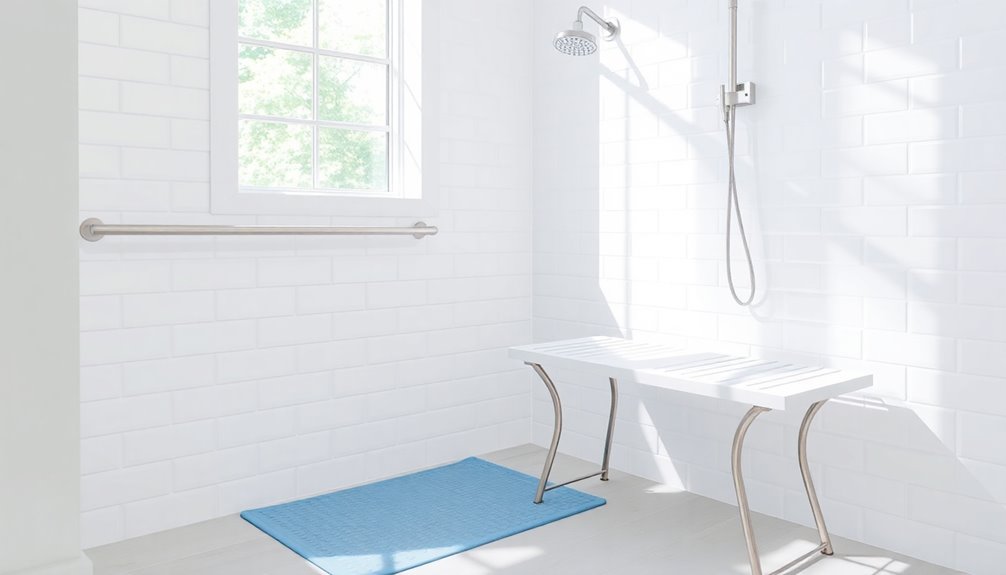To install grab bars effectively, start by choosing the right location, like beside the toilet or in the shower. Use wall studs for secure anchoring and follow the manufacturer's guidelines closely, especially regarding weight capacity. Make sure grab bars are positioned at a height of 33 to 36 inches. You'll also need essential tools like a drill and stud finder. For tips on maintenance and ensuring stability, keep going to learn more!
Key Takeaways
- Choose the right location for grab bars, focusing on critical support areas such as beside the toilet and in the shower.
- Ensure grab bars are installed at a consistent height of 33 to 36 inches for optimal usability and safety.
- Use a stud finder to locate wall studs and secure anchoring; if studs are absent, install wall anchors for support.
- Follow the manufacturer's guidelines, ensuring grab bars have a minimum weight capacity of 250 lbs for safety.
- Conduct regular maintenance checks on installed grab bars to identify and replace any worn or damaged components promptly.
Choose the Right Grab Bar Location
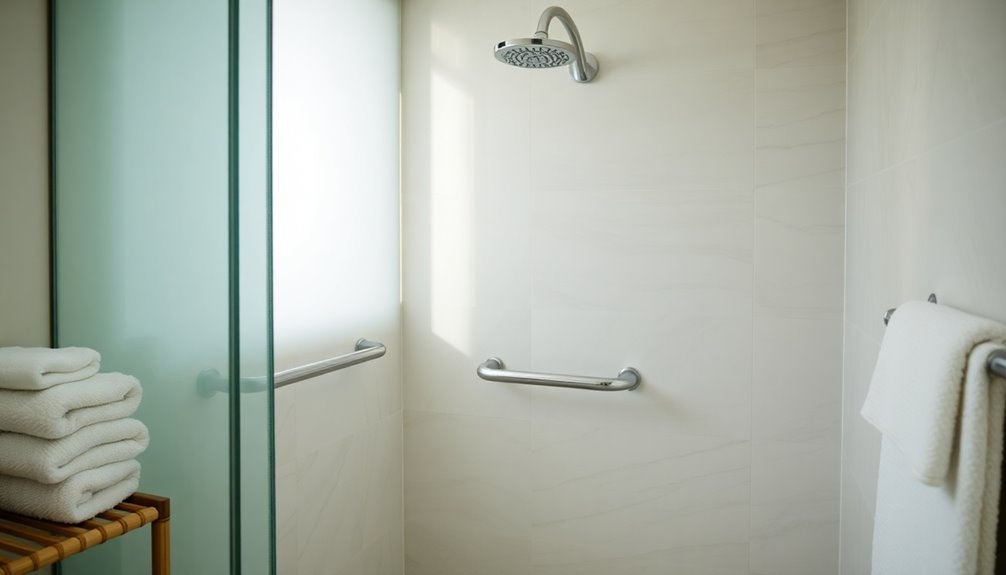
When choosing the right grab bar location, start by identifying critical support areas where you or your loved ones may need assistance, like beside the toilet and in the shower or bathtub.
Prioritize these spots to enhance bathroom safety and guarantee you have support and stability when entering or exiting wet areas.
Position grab bars at heights of 33 to 36 inches for horizontal installations and 18 inches from the corner for vertical bars, optimizing usability.
Consult with users or caregivers to address unique needs, ensuring everyone feels secure.
Planning the layout before installing grab bars helps provide maximum stability, especially for those with mobility issues.
This thoughtful approach can greatly reduce the risk of slips and falls.
Use Studs for Secure Anchoring
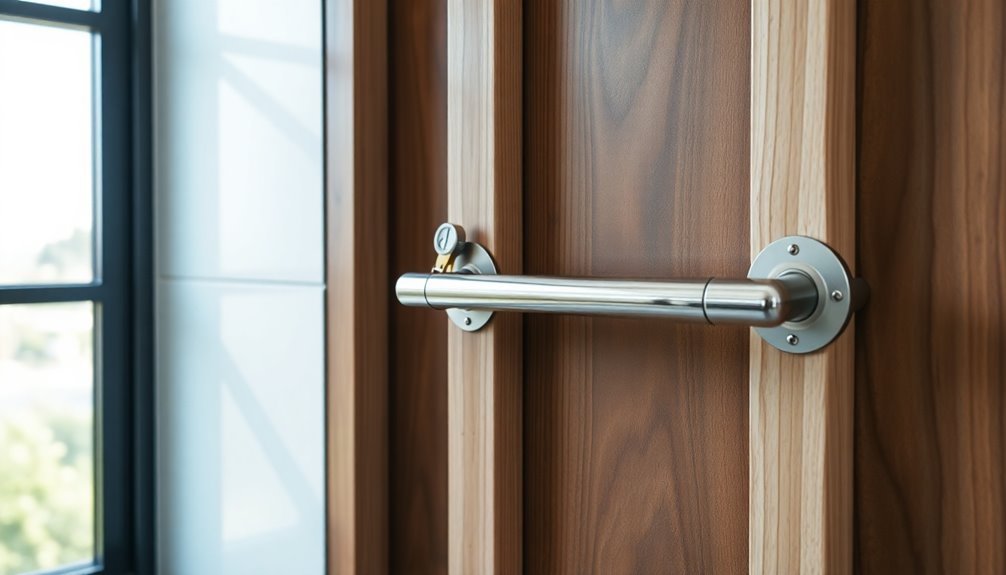
To guarantee your grab bars are safe and stable, you've got to locate wall studs accurately.
Anchoring directly into these studs provides the support needed to handle weight and force without loosening over time.
Using the right installation techniques, like drilling pilot holes, makes all the difference in securing your grab bars effectively.
Locate Wall Studs Accurately
Accurately locating wall studs is essential for securely installing grab bars, as they provide the necessary support to withstand weight and force. Use a stud finder to locate wall studs directly, marking their positions with painter's tape to avoid confusion. When installing shower grab bars, drill pilot holes slightly smaller than the screw shaft into the identified studs for added stability and to prevent wood splitting. For tiled surfaces, confirm stud presence with small pilot holes without cracking the tile. If wall studs aren't available, consider alternative anchoring solutions like toggle bolts to guarantee the grab bars remain safe.
| Action | Importance |
|---|---|
| Use a stud finder | Guarantees accurate location |
| Mark with tape | Prevents confusion during installation |
| Drill pilot holes | Facilitates easier screw insertion |
| Consider alternatives | Guarantees safety if no studs are found |
Secure Installation Techniques
Installing grab bars securely requires anchoring them directly into wall studs, as this provides the strength needed to support weight and resist force.
Start by locating the studs with a stud finder for secure anchoring. When you're ready for grab bar installation, drill pilot holes that are slightly smaller than the screw shaft; this makes fastening into the studs easier and more secure.
Avoid using wall anchors unless absolutely necessary, as they increase the slip risk. For maximum safety, consider reinforcing areas behind shower walls with wood backing, especially if you anticipate needing additional grab bars later. Additionally, using properly seasoned wood for reinforcement can enhance the durability and stability of your installation.
After installation, regularly assess the condition of your grab bars to guarantee ongoing stability and compliance with manufacturer specifications.
Follow the Manufacturer's Guidelines

When installing grab bars, it's essential you follow the manufacturer's guidelines closely to guarantee safety and compliance with regulations.
Each product may have specific instructions that vary, so always consult the manual.
If you're unsure, consider hiring a professional to help with the installation for added peace of mind.
Installation Instructions Importance
One critical reason to follow the manufacturer's installation guidelines is to confirm the safety and reliability of grab bars. The installation instructions importance can't be overstated, as improper installation can compromise structural integrity, leading to potential falls.
Grab bars for seniors must be securely mounted, adhering to weight capacity specifications provided by the manufacturer. Ignoring these can result in dangerous situations where the bar fails under pressure.
It's also wise to consult customer service for any clarification on installation guidelines. If you're unsure about the process, consider hiring a professional contractor familiar with local building codes.
This confirms compliance and maximizes safety, making your home a secure environment for everyone, especially seniors who rely on these essential features.
Compliance With Regulations
Following the manufacturer's guidelines is essential for guaranteeing safe and compliant installation of grab bars.
Always read the specific installation instructions, as they may vary by type and model. Confirm your installation meets ADA (Americans with Disabilities Act) and IRC (International Residential Code) standards, particularly regarding height, placement, and weight capacity.
If you have any questions, don't hesitate to consult the manufacturer's customer service for clarification.
Regularly assess the installed grab bars to maintain compliance with the manufacturer's specifications and safety standards over time.
Remember, proper installation and maintenance are key to guaranteeing that grab bars provide the necessary support and safety for users.
Prioritize these factors to enhance safety in your home or facility.
Professional Help Consideration
While it's tempting to tackle grab bar installation as a DIY project, enlisting a professional can save you time and guarantee compliance with the manufacturer's guidelines and local building codes.
A professional contractor understands the specific installation instructions and can ascertain that the grab bars are placed correctly according to the manufacturer's recommendations. They'll verify that the selected grab bars meet the necessary weight capacities and follow proper anchoring methods to assure safety.
Additionally, hiring an expert allows you to implement all required safety measures, including maintenance checks. This way, you can rest easy knowing your grab bars are securely installed and effective in preventing accidents, giving you peace of mind in your home.
Consider Weight Capacity
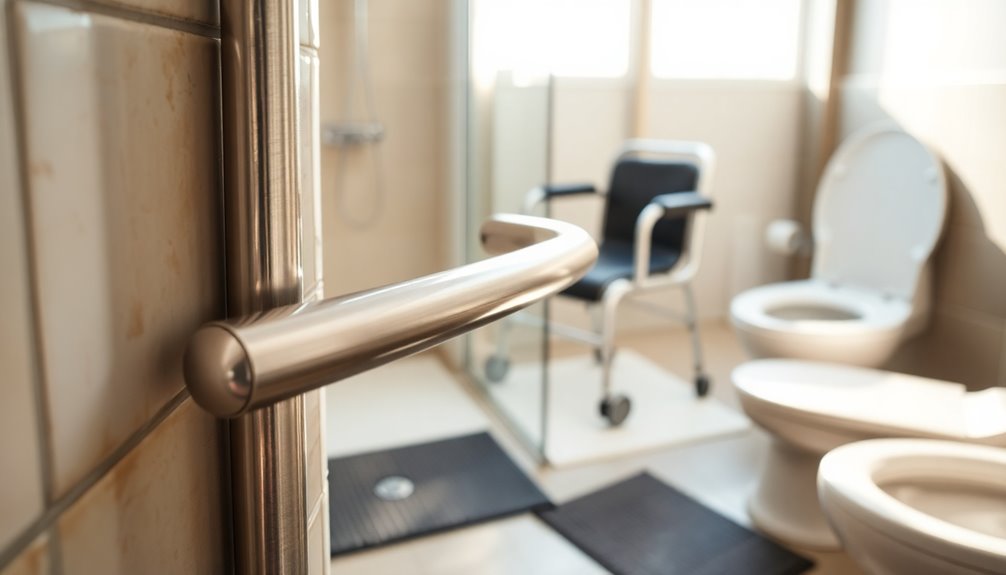
When selecting grab bars, it's vital to take into account their weight capacity to guarantee your safety and reliability. Aim for a minimum weight capacity of 250 lbs to confirm they meet your user needs.
Overloading grab bars beyond their specified limits can compromise their structural integrity, increasing the risk of failure during use. Always check the manufacturer's specifications before purchasing to find suitable options, as some grab bars can support up to 500 lbs for added safety.
Regular maintenance and assessments of installed grab bars are essential to maintain their effectiveness and safety over time. By considering weight capacity during installation, you can ensure that your grab bars will provide the support necessary for safe and confident use.
Mind the Height
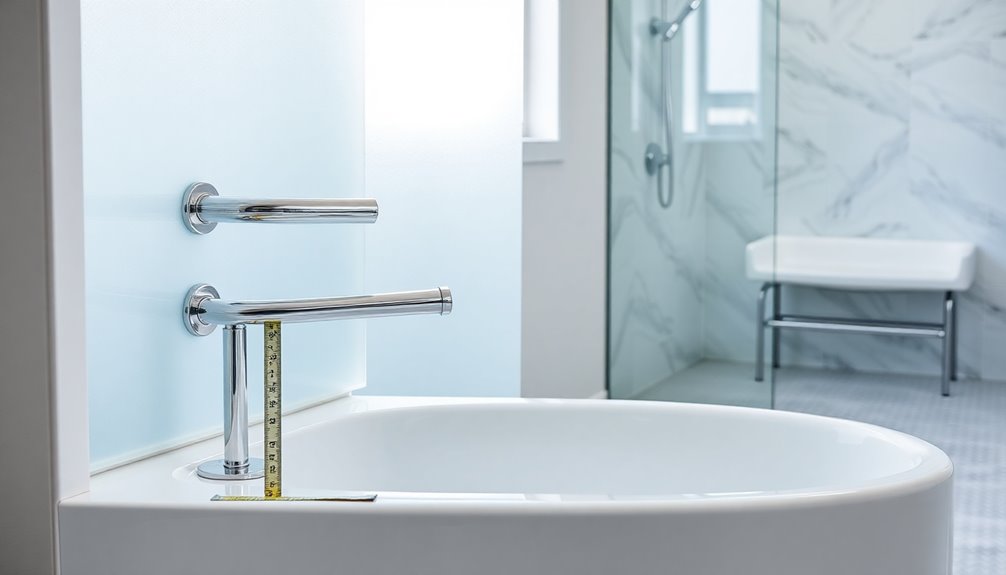
Choosing the right weight capacity for grab bars is just the beginning; height placement is equally important for guaranteeing safety and accessibility. You should install horizontal grab bars between 33 to 36 inches from the finished floor.
For vertical grab bars, position them 18 inches from the wall corner to optimize reach and support.
Consider these tips for effective height placement:
- Adjust height based on individual needs for maximum effectiveness.
- Maintain consistent height across all grab bars for ease of use.
- Confirm proper height enhances stability and reduces fall risks.
Tools and Materials Needed for Installation
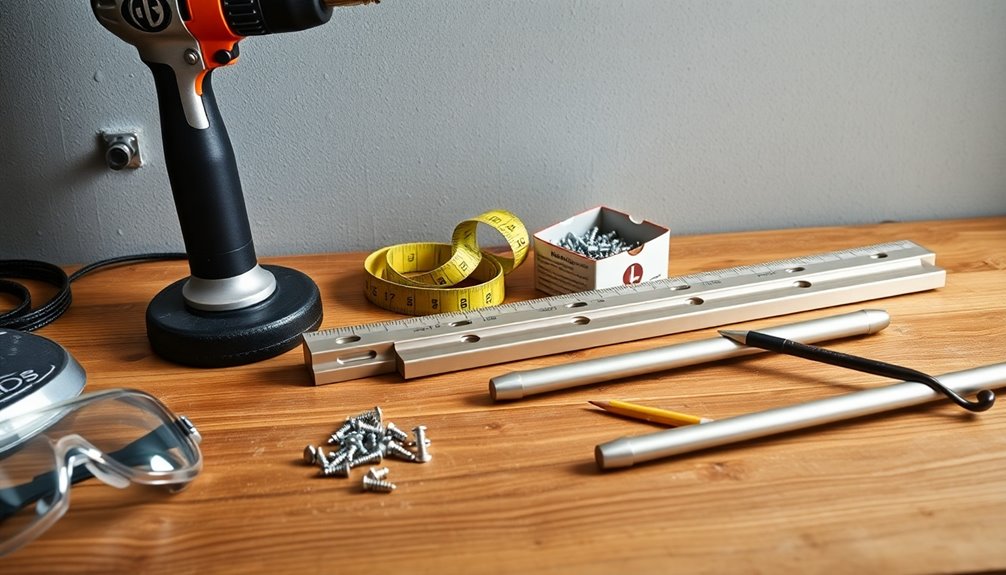
Installing grab bars requires the right tools and materials to guarantee a secure and safe fit. Here's what you need for a successful installation:
| Tool/Material | Purpose | Importance |
|---|---|---|
| Drill/Driver | Make holes for grab bars | Guarantees strong installation |
| Stud Finder | Locate wall studs | Vital for anchoring |
| Tape Measure | Measure height (33-36 inches) | Guarantees proper placement |
| Eye Protection | Protect eyes from debris during drilling | Safety during installation |
| Grab Bars | Provide support | Essential for stability |
| Wall Anchors | Secure bars if studs aren't available | Enhances safety and stability |
With these tools, you'll install grab bars effectively and guarantee safety for users.
Frequently Asked Questions
What Are the ADA Recommendations for Grab Bar Placement?
The ADA recommends placing horizontal grab bars between 33 to 36 inches from the floor for easy access.
If you're installing vertical bars, position them 18 inches from the back wall for better usability in showers or tubs.
For extra support, mount grab bars securely to wall studs, ensuring they can hold at least 250 lbs.
If you have a shower seat, place the back wall grab bar 9 inches above it for ideal assistance during changes.
What Are Two Requirements When Installing Grab Rails in a Bathroom?
Installing grab rails in a bathroom is like securing a lifeline in turbulent waters.
First, make certain you anchor the grab rails into wall studs for maximum stability; loose installations can lead to dangerous falls.
Second, position them at a height of 33 to 36 inches from the floor, accommodating most users effectively.
These two essential requirements guarantee safety and accessibility, creating a secure environment for everyone in your home.
What Are the Rules for Grab Bars in Showers?
When you're installing grab bars in showers, you need to follow specific rules for safety.
Position horizontal bars 33 to 36 inches above the finished floor and place vertical bars 18 inches from the corner, especially if there's a shower seat.
Confirm the bars can support at least 250 pounds and anchor them securely into wall studs.
Finally, check that your installation complies with ADA and IRC codes for maximum accessibility and safety.
How Should Grab Bars Be Installed?
When you're ready to install grab bars, start by locating wall studs using a stud finder.
It's essential they're anchored directly into the studs for maximum support.
Aim for a height between 33 to 36 inches for horizontal bars, while vertical ones should be around 18 inches from the corner.
Don't forget to drill pilot holes slightly smaller than the screws to guarantee a secure fit.
Always follow the manufacturer's guidelines for best results.
Conclusion
Installing grab bars and safety features doesn't have to be intimidating. You might worry about the effort involved, but with the right tools and a little planning, it can be a straightforward project that boosts your safety and confidence at home. Remember, it's all about making your space more secure and accessible. So grab your tools, follow these tips, and take the first step towards a safer living environment—you'll feel great knowing you've done it yourself!
